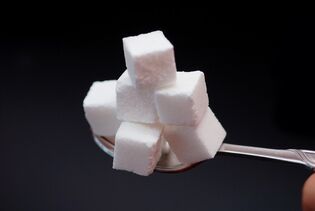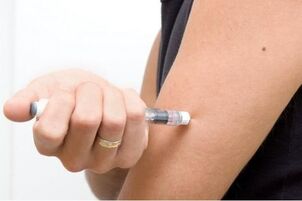
Diabetes is a chronic disease characterized by metabolic disorders due to absolute or relative insulin deficiency. The pancreas is the only organ weighing 70-100 grams, located in the abdominal cavity in the duodenal arch. It plays a key role in the digestion of protein, fat and carbohydrates. It also produces insulin, which regulates carbohydrate metabolism in the body. In this article, we will discuss what nutrients diabetes mellitus should contain.
Types of diabetes
Doctors distinguish between different types of diabetes, because of the cause and course of the disease:
- type I diabetes, insulin dependence;
- type II diabetes, usually occurs later in life, especially in obese patients.
Type I diabetes is usually caused by damage to the pancreas. That is, primary damage to beta cells (which produce insulin in the pancreas) and absolute deficiency in insulin secretion.
The early signs of type I diabetes are intense thirst and hunger, unexplained weight loss, frequent urination of large amounts, blurred vision, fatigue, chronic infections. In some cases, the onset is accompanied by seizures, confusion, slurred speech, loss of consciousness. Type I diabetes mellitus is considered an immunological disease.
Type II diabetes is more common in people who are obese. This disease can be congenital or acquired and is characterized by decreased insulin secretion by the pancreas, as well as insulin resistance. This means that even the right amount of insulin in the body cannot complete the task.
This disease is accompanied by excessive thirst and profuse urination, which slowly raises blood sugar levels. The patient feels weak and sleepy. This disease often starts in middle aged people and the elderly. However, in recent years, there has been a dramatic increase in the number of young patients with type II diabetes. And a large number of children and adolescents with this condition are overweight and obese.
What is Hyperglycemia

Hyperglycemia - blood glucose levels above normal. Symptoms of hyperglycemia include excessive thirst, dry mouth, frequent urination, weight loss, excessive daytime sleepiness.
The most common cause of hyperglycaemia is undiagnosed or poorly controlled diabetes. In diabetics, this condition can occur due to insufficient insulin.
Less commonly, hyperglycemia is the result of infectious and endocrine diseases (acromegaly, Cushing's syndrome). There is a high risk of developing further complications, especially of the cardiovascular system.
Chronic hyperglycemia is associated with dysfunction and damage to multiple organs - eyes, kidneys, nerves, heart and blood vessels.
Proper nutrition for diabetes
In diabetes prevention, diet is a very important part of therapy. It is important to maintain proper blood glucose and lipid levels and optimal blood pressure. A well-chosen diet reduces the risk of diabetes complications and minimizes the risk of vascular disease. A proper diet for diabetes plays an important role in the prevention and treatment of chronic complications of diabetes. Among them are microvascular complications, retinopathy, nephropathy, diabetic neuropathy, and others.
Eating diabetes mellitus is one of the main factors affecting diabetes outcome.
Sugar is essential for life, but in this case it is better to throw away the sugar bowl! In diabetes, metabolism, especially carbohydrates are disturbed. People diagnosed with diabetes should limit their intake of sugar or carbohydrates.

Sugar:
- monosaccharides - glucose and fructose found in fruit and honey;
- sucrose disaccharide is sugar from a sugar bowl;
- polysaccharides - flour products, cakes, biscuits and bread, potatoes, bananas, noodles, dumplings, pasta, pancakes and more.
Carbohydrates for diabetes
Carbohydrates are part of our diet. Their consumption should cover 55-60% of the total demand. Much depends on the form and structure from which carbohydrates originate. Carbohydrates in the digestive tract are digested and broken down into simple sugars - especially glucose.
Please note that excess carbohydrates cause continuous stimulation of beta cells in the pancreas to produce and secrete insulin.
When our sugar levels rise, the pancreas releases insulin. Insulin is a hormone that allows glucose to enter cells. Simple sugars, such as glucose, are quickly transported into cells in about an hour.
Unfortunately, insulin is a hormone that lasts several hours and does not like "getting out of work. "Thus, an increase in insulin levels causes fluctuations in blood glucose levels and a hunger for carbohydrates.
A hungry person opens the refrigerator and starts eating to satisfy this hunger. The adrenal glands receive information: blood glucose fluctuations. All of these reactions are signals for the adrenal glands to release adrenaline. This creates a vicious cycle that causes stress, depression, and autonomic neurosis (neurasthenia).
Therefore, it is highly recommended to reduce your carbohydrate intake to a minimum. In such situations, fluctuations in blood glucose levels and excessive production of the hormones insulin and adrenaline do not occur.

Glucose passes through the walls of the digestive tract, and with blood enters various organs, where it is converted and becomes a source of energy. In the absence of adequate exercise, energy requirements decrease, glucose is stored as glycogen in muscles and liver.
If in excess, glycogen is converted to fat, leading to fatty liver and a further accumulation of excess body fat. The process of glucose metabolism is controlled by insulin, a hormone produced in the pancreas.
Carbohydrates, the main energy ingredient, can only enter cells with the help of insulin, which distributes simple sugars to the body. However, a deficiency of insulin, for example, causes an increase in blood sugar levels followed by a severe cellular metabolism. Lack of insulin generally causes diabetes in children and adolescents - type I diabetes.
Protein in diabetes mellitus
Protein must meet 10-15% of energy needs. Larger numbers are needed for children during their infancy, for pregnant women. The most valuable - animal protein is found in lean meat, cottage cheese, eggs and sour milk.
Since our bodies can produce 56 g of sugar per 100 g of protein, it is also important to limit protein intake. In order not to harm the body, you need to consume high-quality protein (egg yolks, leftover meat). Sources of vegetable protein are - soybeans, beans, dark bread made from whole wheat flour.
Diets for diabetes mellitus do's and don'ts
In the diet for diabetes mellitus, the first stage of treatment should include foods such as egg yolks, butter, sour cream, milk, and unsweetened vegetables.
Right now, you need to significantly reduce or eliminate your diet: egg whites, lean meats, fish, poultry, and nuts.
Diabetics should not eat or eat high protein foods at night. At night, the body can't use it. Because the pancreas doesn't release enough insulin, blood glucose levels rise in the morning. In this case, a dinner consisting mostly of carbohydrates and fats is recommended.
Fat contains the most energy. They can only cover 30% of daily energy consumption. In excess, they contribute to the development of obesity.
Spices like cinnamon, garlic, cloves, turmeric, and bay leaf lower cholesterol and blood glucose levels.
Can Diabetics Eat Fruits and Vegetables? Yes, because they are rich in vitamins and minerals. Fresh vegetables, including broccoli, are ideal for diabetics as a great source of chromium. Onions that work to release insulin. Skin potatoes (boiled potatoes raise blood sugar too quickly), asparagus, raw carrots, fresh cucumbers, sauerkraut, elderberry leaves and tea stalks, and garlic.

Vegetables that you can eat without meaningful restrictions:
- tomatoes;
- fresh and pickled cucumbers;
- raw and sauerkraut;
- chicory;
- kohlrabi;
- radishes;
- paprika;
- lettuce
- mushrooms;
- zucchini.
An excellent anti-diabetic agent - fresh blueberry leaves, which are harvested before the fruit is ripe. Blueberries May Prevent Diabetic Retinopathy - Research has shown a significant improvement in vision in people suffering from eye disease during diabetes. This disease causes changes in the fundus, which significantly interfere with blood flow to the eye.
Diabetics who are overweight (BMI above 25) are advised to limit calorie intake to reduce body weight.
Food Glycemic Index
Blood glucose is affected not only by the amount of carbohydrates, but also by the type. Therefore, it is necessary to control the amount and quality of carbohydrates in food, but it is also desirable to calculate the glycemic index of the product.
Low GI foods are slow to digest and absorb, do not raise blood glucose rapidly, and do not stimulate insulin secretion. A low GI diet reduces the risk of developing insulin-dependent diabetes.
The higher the GI value of a food, the higher the blood glucose level after consuming that food. Foods with a high GI increase such as blood glucose. Slow absorption and gradual increase and decrease in blood sugar after eating a low GI diet help control blood sugar in diabetics. It is best to eat foods that have a GI of less than 60.
The GI of food is much lower when it is consumed in its natural form, that is, raw and unprocessed.
Diabetics are also advised to abstain from alcohol.














































































